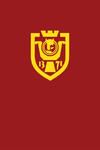Kruševac
| Kruševac Град Крушевац | |||
|---|---|---|---|
| City | |||
| City of Kruševac | |||
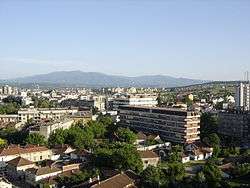 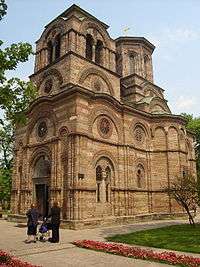 Clockwise, from top: Panorama of Kruševac, County Authorities Building, Lazarica Church | |||
| |||
 Location of the city of Kruševac within Serbia | |||
| Coordinates: 43°35′N 21°19′E / 43.583°N 21.317°ECoordinates: 43°35′N 21°19′E / 43.583°N 21.317°E | |||
| Country |
| ||
| Region | Šumadija and Western Serbia | ||
| District | Rasina | ||
| Founded | 1371 | ||
| Founded by | Lazar of Serbia | ||
| Settlements | 101 | ||
| Government | |||
| • Mayor | Jasmina Palurović (SNS) | ||
| Area[1] | |||
| Area rank | 20th in Serbia | ||
| • Urban | 11.30 km2 (4.36 sq mi) | ||
| • Administrative | 854 km2 (330 sq mi) | ||
| Elevation | 163 m (535 ft) | ||
| Population (2011 census)[2] | |||
| • Rank | 7th in Serbia | ||
| • Urban | 73,316 | ||
| • Urban density | 6,500/km2 (17,000/sq mi) | ||
| • Administrative | 128,752 | ||
| • Administrative density | 150/km2 (390/sq mi) | ||
| Time zone | UTC+1 (CET) | ||
| • Summer (DST) | UTC+2 (CEST) | ||
| Postal code | 37000 | ||
| Area code | +381(0)37 | ||
| Car plates | KŠ | ||
| Website |
www | ||
Kruševac (Serbian Cyrillic: Крушевац [krûʃeʋats] (![]()
The city was founded in 1371, by Prince Lazar of Serbia (1371–1389), who used it as his seat.
Etymology
The etymology is derived from the Serbian word for "river stone", krušac which was largely used for a building at that time.
History
Kruševac was founded in 1371, as a fortified town in the possession of Lord Lazar Hrebeljanović. The Lazarica Church (or Church of St, Stephen) was built by Lazar between 1375–78, in the Morava architectural style.[3] It is mentioned in one of Lazar's edicts in 1387, as his seat, when he affirmed the rights of Venetian merchants on Serbian territory. In preparation for the Battle of Kosovo (1389) against the Ottoman Empire, the Serbian army assembled in the city. The site of Lazar's palace is marked by a ruined enclosure containing a fragment of the tower of his spouse Princess Milica, and, according to legend, tidings of the defeat were brought to her by crows from the battlefield. After the battle, the city was held by Princess Milica as her seat. The little that remains of Lazar's city is the Kruševac Fortress, which was declared a Cultural Monument of Exceptional Importance in 1979.[4] Several old Ottoman houses were left at the beginning of the 20th century, besides an old Turkish fountain and bath, which was known as Alacahisar (Aladža Hisar) during Ottoman rule between 1427–1833 (nominally to 1867) when Kruševac was the seat of the Sanjak of Kruševac. The Ottoman rule was interrupted during Austrian occupations between 1688–1690 and 1717–1739.
A large monument dedicated to the fallen Serbs at the Battle of Kosovo was sculpted by Petar Ubaković (1852–1910). A part of the monument is also a statue of the famous blind Serbian poet Filip Višnjić.
During World War II there was a mass executions of patriots and antifascists on hill Bagdala. Largest execution was in summer of 1943. At place of executions now is a monument named Slobodište (from the serbian word "sloboda" what means freedom). Kruševac was liberated on 14. october when chetnik collaborators and Germans together left the city.
Kruševac had a large progress during period of SFRY. That period, large number of factories were built and Kruševac become one of strongest industrial centrals in Serbia and Yugoslavia. Machine factory IMK 14. oktobar Kruševac employed around 7,000 workers.
But large Kruševac industry have not survived the NATO bombing and post-Milošević transition. In 2002 alone 5 factories went bankrupt.[5] From 2002 to 2014 27 factories closed and around 11,000 workers lost their jobs[6]. The unemployment rate in Kruševac is 39%.[7]
Settlements
Aside from the urban area of Kruševac, the city administrative area includes the following 100 settlements:
- Begovo Brdo
- Bela Voda
- Belasica
- Bivolje
- Bovan
- Bojince
- Boljevac
- Brajkovac
- Bukovica
- Buci
- Velika Kruševica
- Velika Lomnica
- Veliki Kupci
- Veliki Šiljegovac
- Veliko Golovode
- Veliko Krušince
- Vitanovac
- Vratare
- Vučak
- Gavez
- Gaglovo
- Gari
- Globare
- Globoder
- Gornji Stepoš
- Grevci
- Grkljane
- Dvorane
- Dedina
- Dobromir
- Doljane
- Donji Stepoš
- Đunis
- Žabare
- Zdravinje
- Zebica
- Zubovac
- Jablanica
- Jasika
- Jošje
- Kamenare
- Kaonik
- Kapidžija
- Kobilje
- Komorane
- Konjuh
- Koševi
- Krvavica
- Kukljin
- Lazarevac
- Lazarica
- Lipovac
- Lovci
- Lukavac
- Ljubava
- Majdevo
- Makrešane
- Mala Vrbnica
- Mala Reka
- Mali Kupci
- Mali Šiljegovac
- Malo Golovode
- Malo Krušince
- Mačkovac
- Meševo
- Modrica
- Mudrakovac
- Naupare
- Padež
- Pakašnica
- Parunovac
- Pasjak
- Pepeljevac
- Petina
- Pozlata
- Poljaci
- Ribare
- Ribarska Banja
- Rlica
- Rosica
- Sebečevac
- Sezemče
- Slatina
- Srndalje
- Srnje
- Stanci
- Suvaja
- Sušica
- Tekije
- Trebotin
- Trmčare
- Ćelije
- Cerova
- Crkvina
- Čitluk
- Šavrane
- Šanac
- Šašilovac
- Šogolj
- Štitare
Demographics
| Historical population | ||
|---|---|---|
| Year | Pop. | ±% p.a. |
| 1948 | 87,853 | — |
| 1953 | 94,827 | +1.54% |
| 1961 | 103,190 | +1.06% |
| 1971 | 118,016 | +1.35% |
| 1981 | 132,972 | +1.20% |
| 1991 | 138,111 | +0.38% |
| 2002 | 131,368 | −0.45% |
| 2011 | 128,752 | −0.22% |
| Source: [8] | ||
According to the 2011 census results, the city of Kruševac has a total population of 128,752 inhabitants.
Ethnic groups
The ethnic composition of the city administrative area:[9]
| Ethnic group | Population |
|---|---|
| Serbs | 122,529 |
| Roma | 2,461 |
| Montenegrins | 282 |
| Macedonians | 200 |
| Croats | 107 |
| Yugoslavs | 86 |
| Total | 128,752 |
Economy
The most notable large companies based in the city of Kruševac are: Trayal Corporation, IMK 14. oktobar Kruševac, Rubin and Cooper Tire & Rubber Company Serbia.
The following table gives a preview of total number of employed people per their core activity (as of 2016):[10]
| Activity | Total |
|---|---|
| Agriculture, forestry and fishing | 368 |
| Mining | 15 |
| Processing industry | 6,804 |
| Distribution of power, gas and water | 599 |
| Distribution of water and water waste management | 673 |
| Construction | 1,222 |
| Wholesale and retail, repair | 5,002 |
| Traffic, storage and communication | 1,303 |
| Hotels and restaurants | 858 |
| Media and telecommunications | 313 |
| Finance and insurance | 573 |
| Property stock and charter | 213 |
| Professional, scientific, innovative and technical activities | 992 |
| Administrative and other services | 371 |
| Administration and social assurance | 1,860 |
| Education | 2,163 |
| Healthcare and social work | 2,753 |
| Art, leisure and recreation | 586 |
| Other services | 580 |
| Total | 27,249 |
Politics
Seats in the city parliament won in the 2016 local elections:
| Party | Seats |
|---|---|
| Serbian Progressive Party | 53 |
| Socialist Party of Serbia | 8 |
| Democratic Party | 4 |
| United Serbia | 4 |
| Independent MP | 1 |
Sports
The city's main football club is FK Napredak Kruševac, who regularly play in the Serbian SuperLiga.
Climate
| Climate data for Kruševac (1981–2010, extremes 1961–2010) | |||||||||||||
|---|---|---|---|---|---|---|---|---|---|---|---|---|---|
| Month | Jan | Feb | Mar | Apr | May | Jun | Jul | Aug | Sep | Oct | Nov | Dec | Year |
| Record high °C (°F) | 20.4 (68.7) |
24.2 (75.6) |
29.6 (85.3) |
31.9 (89.4) |
35.5 (95.9) |
39.6 (103.3) |
43.7 (110.7) |
42.4 (108.3) |
36.8 (98.2) |
33.8 (92.8) |
27.4 (81.3) |
21.7 (71.1) |
43.7 (110.7) |
| Average high °C (°F) | 4.6 (40.3) |
7.2 (45) |
12.5 (54.5) |
18.0 (64.4) |
23.1 (73.6) |
26.4 (79.5) |
28.7 (83.7) |
29.0 (84.2) |
24.1 (75.4) |
18.5 (65.3) |
11.4 (52.5) |
5.6 (42.1) |
17.4 (63.3) |
| Daily mean °C (°F) | 0.2 (32.4) |
2.0 (35.6) |
6.6 (43.9) |
11.8 (53.2) |
16.8 (62.2) |
20.0 (68) |
21.8 (71.2) |
21.5 (70.7) |
16.8 (62.2) |
11.6 (52.9) |
5.9 (42.6) |
1.6 (34.9) |
11.4 (52.5) |
| Average low °C (°F) | −3.4 (25.9) |
−2.3 (27.9) |
1.5 (34.7) |
5.6 (42.1) |
10.2 (50.4) |
13.5 (56.3) |
14.9 (58.8) |
14.6 (58.3) |
10.7 (51.3) |
6.3 (43.3) |
1.6 (34.9) |
−1.9 (28.6) |
5.9 (42.6) |
| Record low °C (°F) | −28.1 (−18.6) |
−23.7 (−10.7) |
−17.2 (1) |
−6.1 (21) |
−1.1 (30) |
2.9 (37.2) |
5.8 (42.4) |
3.0 (37.4) |
−3.0 (26.6) |
−7.3 (18.9) |
−21.4 (−6.5) |
−23.9 (−11) |
−28.1 (−18.6) |
| Average precipitation mm (inches) | 40.3 (1.587) |
39.2 (1.543) |
48.4 (1.906) |
56.6 (2.228) |
56.9 (2.24) |
71.2 (2.803) |
55.0 (2.165) |
49.8 (1.961) |
50.0 (1.969) |
49.3 (1.941) |
56.2 (2.213) |
55.1 (2.169) |
628.1 (24.728) |
| Average precipitation days (≥ 0.1 mm) | 13 | 12 | 12 | 13 | 12 | 11 | 10 | 8 | 9 | 9 | 11 | 14 | 134 |
| Average snowy days | 8 | 8 | 4 | 1 | 0 | 0 | 0 | 0 | 0 | 0 | 3 | 7 | 31 |
| Average relative humidity (%) | 85 | 79 | 73 | 71 | 72 | 72 | 70 | 69 | 74 | 79 | 81 | 85 | 76 |
| Mean monthly sunshine hours | 54.0 | 78.7 | 129.1 | 154.0 | 206.0 | 223.2 | 269.0 | 263.2 | 190.6 | 137.2 | 79.1 | 42.6 | 1,826.7 |
| Source: Republic Hydrometeorological Service of Serbia[11] | |||||||||||||
Famous residents
- Stefan Lazarević (1377–1427), medieval ruler of Serbia
- Stojan Protić (1857–1923), Prime Minister of the Kingdom of Serbs, Croats and Slovenes 1918–1919, 1920
- Stanislav Binički (1872–1942), Serbian composer (Marš na Drinu)
- Dobrica Ćosić (1921–2014), Serbian writer, first President of FR Yugoslavia
- Taško Načić (1934–1993), Serbian actor
- Miodrag Petrović Čkalja (1924–2003), One of the most popular Serbian comedians
- Bata Paskaljević (1923–2004), Serbian actor
- Radmila Savićević (1926–2001), Serbian actress
- Ljiljana Jovanović (1930–2012), Serbian actress
- Vojin Ćetković (b. 1971), Serbian actor
- Nataša Tapušković (b. 1975), Serbian actress
- Branislav Trifunović (b. 1978), Serbian actor
- Miroslav Mišković (b. 1945), Serbian businessman
- Dragiša Binić (b. 1961), Serbian footballer, 1990–91 European Cup winner
- Milić Jovanović (b. 1966), Serbian footballer, 1990–91 European Cup winner
- Ognjen Petrović (b. 1948), Serbian footballer
- Bojan Zajić (b. 1980), Serbian footballer
- Predrag Pavlović (b. 1986), Serbian footballer
- Milan Gajić (b. 1986), Serbian footballer
- Nikola Milošević (b. 1993), Serbian footballer
- Predrag Jovanović (b. 1950), Serbian musician
- Nebojša Bradić (b. 1956), Serbian theatre director, and former Minister of Culture
- Goran Grbović (b. 1961), Serbian basketball player, bronze medalist at the EuroBasket 1987
- Dragan Milosavljević (b. 1989), Serbian basketball player, silver medalist at the EuroBasket 2017
- Ognjen Jaramaz (b. 1995), Serbian basketball player
- Aleksandar Mitrović (b. 1982), Serbian volleyball player
- Tijana Bogdanović (b. 1998), Serbian taekwondo practitioner, European champion and silver medalist at the 2016 Summer Olympics
- Sanja Vučić (born 1993), Serbian singer who represented Serbia in the Eurovision Song Contest 2016
International relations
Twin towns — Sister cities
Kruševac is twinned with:
|
Other forms of co-operation and city friendship similar to the twin/sister city programmes:
|
Gallery
 Main train station in the town
Main train station in the town Belfry
Belfry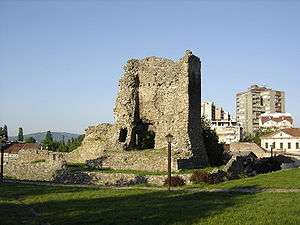 Middle Ages era ruins in Kruševac
Middle Ages era ruins in Kruševac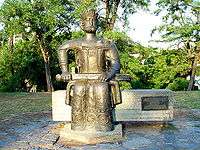 Lazar Hrebeljanović's statue in Kruševac
Lazar Hrebeljanović's statue in Kruševac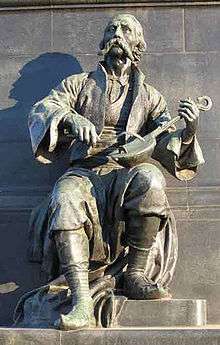 Filip Višnjić's statue in Kruševac
Filip Višnjić's statue in Kruševac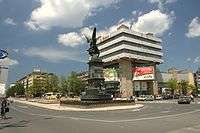 The Kosovo Heroes Square
The Kosovo Heroes Square- The Kosovo Heroes Square
 Kruševac panorama
Kruševac panorama- town hall
- town hall
See also
References
- ↑ "Municipalities of Serbia, 2006". Statistical Office of Serbia. Retrieved 2010-11-28.
- ↑ "2011 Census of Population, Households and Dwellings in the Republic of Serbia: Comparative Overview of the Number of Population in 1948, 1953, 1961, 1971, 1981, 1991, 2002 and 2011, Data by settlements" (PDF). Statistical Office of Republic Of Serbia, Belgrade. 2014. ISBN 978-86-6161-109-4. Retrieved 2014-06-27.
- ↑ Filip Jovanovic i Djordje Banovic. "Istorija – Crkva Lazarica – Kruševac – Srpska Pravoslavna Crkva". Lazarica.rs. Archived from the original on 31 March 2012. Retrieved 26 March 2013.
- ↑ Monuments of Culture in Serbia: ЦРКВА СВ.СТЕФАНА ЛАЗАРИЦА СА КРУШЕВАЧКИМ ГРАДОМ (SANU) (in Serbian) (in English)
- ↑ http://krusevacgrad.rs/svi-nasi-porazi-vecina-krusevackih-restrukturasa-zavrsila-u-stecaju/
- ↑ http://krusevacgrad.rs/svi-nasi-porazi-vecina-krusevackih-restrukturasa-zavrsila-u-stecaju/
- ↑ http://www.blic.rs/vesti/politika/pajtic-krusevac-dotakao-dno-za-vreme-vlasti-sns/ed111nx
- ↑ "2011 Census of Population, Households and Dwellings in the Republic of Serbia" (PDF). stat.gov.rs. Statistical Office of the Republic of Serbia. Archived from the original (PDF) on 14 July 2014. Retrieved 11 January 2017.
- ↑ "ETHNICITY Data by municipalities and cities" (PDF). stat.gov.rs. Statistical Office of the Republic of Serbia. Retrieved 20 February 2018.
- ↑ "ОПШТИНЕ И РЕГИОНИ У РЕПУБЛИЦИ СРБИЈИ, 2017" (PDF). stat.gov.rs (in Serbian). Statistical Office of the Republic of Serbia. Retrieved 18 February 2018.
- ↑ "Monthly and annual means, maximum and minimum values of meteorological elements for the period 1981 - 2010" (in Serbian). Republic Hydrometeorological Service of Serbia. Retrieved March 13, 2017.
- ↑ "AllCorfu.Com: Corfu's Twin Cities". allcorfu.com. Retrieved 25 February 2010.
External links
| Wikimedia Commons has media related to Kruševac. |
- City of Kruševac Website
- krusevac.link – Independent Website
- Internet portal Kruševac – Independent Website
- KruševacPRESS – the first private owned officially registered Kruševac-based Internet media
- Kruševčki internet portal 37000.info
- Kruševac Online
- Politički portal Rasinskog okruga
- Kruševac Info portal grada
- Swimming club Napredak Kruševac
